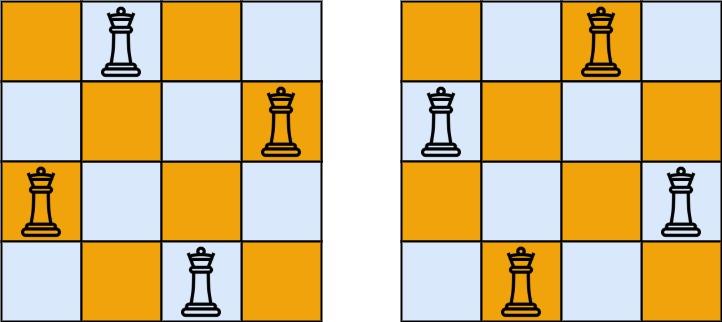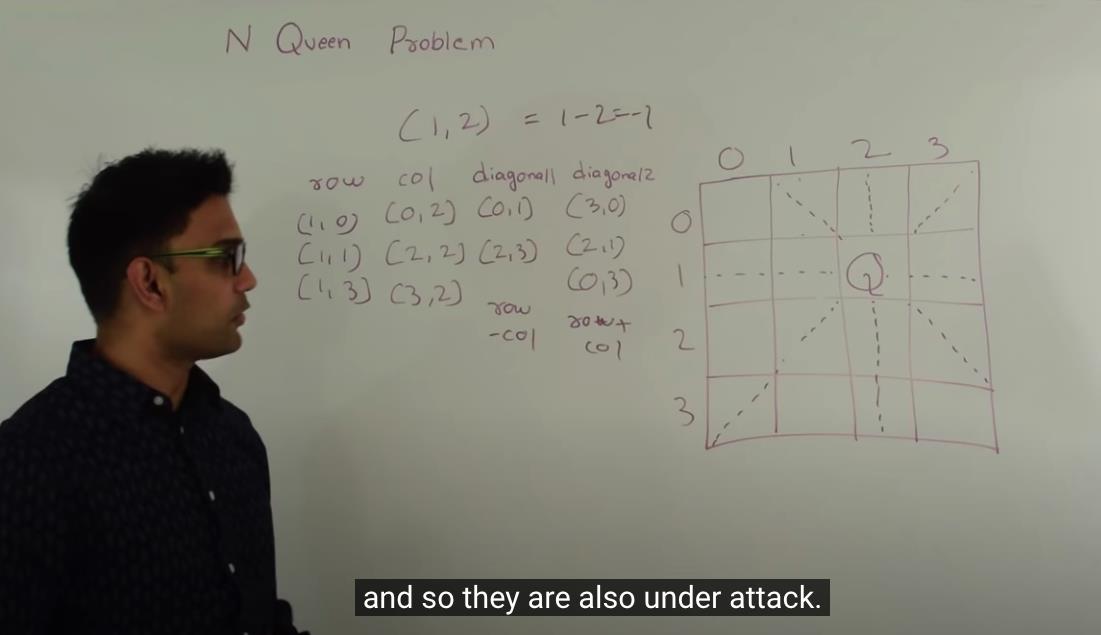算法:N皇后问题51. N-Queens
Posted 架构师易筋
tags:
篇首语:本文由小常识网(cha138.com)小编为大家整理,主要介绍了算法:N皇后问题51. N-Queens相关的知识,希望对你有一定的参考价值。
51. N-Queens
The n-queens puzzle is the problem of placing n queens on an n x n chessboard such that no two queens attack each other.
Given an integer n, return all distinct solutions to the n-queens puzzle. You may return the answer in any order.
Each solution contains a distinct board configuration of the n-queens’ placement, where ‘Q’ and ‘.’ both indicate a queen and an empty space, respectively.
Example 1:

Input: n = 4
Output: [[".Q..","...Q","Q...","..Q."],["..Q.","Q...","...Q",".Q.."]]
Explanation: There exist two distinct solutions to the 4-queens puzzle as shown above
Example 2:
Input: n = 1
Output: [["Q"]]
Constraints:
1 <= n <= 9
深度优先回溯解法
下面的推导出Queen可以互相攻击的公式
- 行相同
x == row - 列相同
y == col - 左对角线相同
x - y = row - col - 右对角线相同
x + y = row + col

用树形结构调用,形象化recursive回溯调用路径

The reason it checks (x + j == y + i || x + y == i + j || x == i):
Every time we find a existing ‘Q’, 3 conditions need to be met before we can place a new ‘Q’ in the new column:
- no confict in columns : self explanatory as we put ‘Q’ col by col.
- no confict in rows :
x == i - no conflict in diagonals :
Math.abs(x-i) == Math.abs(y-j)
ForMath.abs(x-i) == Math.abs(y-j),
if x > i, y > j , x - i = y - j => x + j = y + i
if x < i, y < j, i - x = j - y => x + j = y + i
if x > i, y < j, x - i = j - y => x + y = i + j
if x < i, y > j, i - x = y - j => x + y = i + j
class Solution {
public List<List<String>> solveNQueens(int n) {
List<List<String>> list = new ArrayList<>();
char[][] board = new char[n][n];
for (int x = 0; x < n; x++)
for (int y = 0; y < n; y++)
board[x][y] = '.';
dfs(list, board, n, 0);
return list;
}
private void dfs(List<List<String>> list, char[][] board, int n, int colIndex) {
if (colIndex == n) {
addResult(list, board);
return;
}
for (int row = 0; row < n; row++) {
if (validate(board, n, row, colIndex)) {
board[row][colIndex] = 'Q';
dfs(list, board, n, colIndex + 1);
board[row][colIndex] = '.';
}
}
}
private void addResult(List<List<String>> list, char[][] board) {
List<String> rowList = new ArrayList<>();
for (char[] rows: board)
rowList.add(new String(rows));
list.add(rowList);
}
private boolean validate(char[][] board, int n, int x, int y) {
for (int r = 0; r < n; r++) {
for (int c = 0; c < n; c++) {
if (board[r][c] == 'Q' && (x == r || y == c || x + c == y + r || x + y == r + c)) {
return false;
}
}
}
return true;
}
}
效率更高,更好理解的算法
上个算法要6ms,对上面的进行两个部分优化,可以降低到2ms
- validate 的方法只要验证,小于当前位置的列、左斜对角、右斜对角即可;因为上一层已经是校验过的,所以就不用再次校验;
- dfs校验row的维度更好理解;

class Solution {
public List<List<String>> solveNQueens(int n) {
List<List<String>> list = new ArrayList<>();
char[][] board = new char[n][n];
for (int x = 0; x < n; x++)
for (int y = 0; y < n; y++)
board[x][y] = '.';
dfs(list, board, n, 0);
return list;
}
private void dfs(List<List<String>> list, char[][] board, int n, int row) {
// terminate
if (row == n) {
// todo 1:
addResult(list, board);
return;
}
for (int col = 0; col < n; col++) {
// todo 2:
if (validate(board, n, row, col)) {
// update status
board[row][col] = 'Q';
// drill down
dfs(list, board, n, row + 1);
// reset status
board[row][col] = '.';
}
}
}
private void addResult(List<List<String>> list, char[][] board) {
List<String> itemList = new ArrayList<>();
for (char[] item: board) {
itemList.add(new String(item));
}
list.add(itemList);
}
private boolean validate(char[][] board, int n, int row, int col) {
for (int x = 1; x <= row; x++) {
int currentX = row - x;
if (board[currentX][col] == 'Q') return false;
int leftDiagonal = col - x;
if (leftDiagonal >= 0 && board[currentX][leftDiagonal] == 'Q') return false;
int rightDiagonal = col + x;
if (rightDiagonal < n && board[currentX][rightDiagonal] == 'Q') return false;
}
return true;
}
}
参考
https://leetcode.com/problems/n-queens/discuss/19805/My-easy-understanding-Java-Solution
This video by tushar roy explains the validate function well:
https://youtu.be/xouin83ebxE?t=92
以上是关于算法:N皇后问题51. N-Queens的主要内容,如果未能解决你的问题,请参考以下文章
leetcode 51. N-Queens N 皇后(困难)